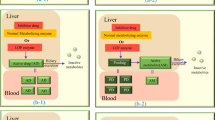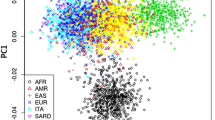Abstract
Adverse drug reactions (ADRs) have a major impact on patients, physicians, health care providers, regulatory agencies and pharmaceutical companies. Identifying the genetic contributions to ADR risk may lead to a better understanding of the underlying mechanisms, identification of patients at risk and a decrease in the number of events. Technological advances have made the routine monitoring and investigation of the genetic basis of ADRs during clinical trials possible. We demonstrate through simulation that genome-wide genotyping, coupled with the use of clinically matched or population controls, can yield sufficient statistical power to permit the identification of strong genetic predictors of ADR risk in a prospective manner with modest numbers of ADR cases. The results of a 500 000 single nucleotide polymorphism analysis of abacavir-associated hypersensitivity reaction suggest that the known HLA-B gene region could be identified with as few as 15 cases and 200 population controls in a sequential analysis.
This is a preview of subscription content, access via your institution
Access options
Subscribe to this journal
Receive 6 print issues and online access
$259.00 per year
only $43.17 per issue
Buy this article
- Purchase on Springer Link
- Instant access to full article PDF
Prices may be subject to local taxes which are calculated during checkout




Similar content being viewed by others
Abbreviations
- ABC:
-
abacavir
- ADR:
-
adverse drug reaction
- GRR:
-
genotype relative risk
- HSR:
-
hypersensitivity reaction
- LD:
-
linkage disequilibrium
- MHC:
-
major histocompatibility complex
- SNP:
-
single nucleotide polymorphism
References
Edwards IR, Aronson JK . Adverse drug reactions: definitions, diagnosis, and management. Lancet 2000; 356: 1255–1259.
Dimasi JA . Risks in new drug development: approval success rates for investigational drugs. Clin Pharmacol Ther 2001; 69: 297–307.
Wysowski DK, Swartz L . Adverse drug event surveillance and drug withdrawals in the United States, 1969–2002: the importance of reporting suspected reactions. Arch Intern Med 2005; 165: 1363–1369.
Lazarou J, Pomeranz BH, Corey PN . Incidence of adverse drug reactions in hospitalized patients: a meta-analysis of prospective studies. JAMA 1998; 279: 1200–1205.
Pirmohamed M, James S, Meakin S, Green C, Scott AK, Walley TJ et al. Adverse drug reactions as cause of admission to hospital: prospective analysis of 18 820 patients. BMJ 2004; 329: 15–19.
Cusatis G, Gregorc V, Li J, Spreafico A, Ingersoll RG, Verweij J et al. Pharmacogenetics of ABCG2 and adverse reactions to gefitinib. J Natl Cancer Inst 2006; 98: 1739–1742.
Huang YS, Chern HD, Su WJ, Wu JC, Chang SC, Chiang CH et al. Cytochrome P450 2E1 genotype and the susceptibility to antituberculosis drug-induced hepatitis. Hepatology 2003; 37: 924–930.
Innocenti F, Undevia SD, Iyer L, Chen PX, Das S, Kocherginsky M et al. Genetic variants in the UDP-glucuronosyltransferase 1A1 gene predict the risk of severe neutropenia of irinotecan. J Clin Oncol 2004; 22: 1382–1388.
Rouits E, Boisdron-Celle M, Dumont A, Guerin O, Morel A, Gamelin E . Relevance of different UGT1A1 polymorphisms in irinotecan-induced toxicity: a molecular and clinical study of 75 patients. Clin Cancer Res 2004; 10: 5151–5159.
Hetherington S, Hughes AR, Mosteller M, Shortino D, Baker KL, Spreen W et al. Genetic variations in HLA-B region and hypersensitivity reactions to abacavir. Lancet 2002; 359: 1121–1122.
Danoff TM, Campbell DA, McCarthy LC, Lewis KF, Repasch MH, Saunders AM et al. A Gilbert's syndrome UGT1A1 variant confers susceptibility to tranilast-induced hyperbilirubinemia. Pharmacogenomics J 2004; 4: 49–53.
Relling MV, Hancock ML, Rivera GK, Sandlund JT, Ribeiro RC, Krynetski EY et al. Mercaptopurine therapy intolerance and heterozygosity at the thiopurine S-methyltransferase gene locus. J Natl Cancer Inst 1999; 91: 2001–2008.
Hung SI, Chung WH, Liou LB, Chu CC, Lin M, Huang HP et al. HLA-B*5801 allele as a genetic marker for severe cutaneous adverse reactions caused by allopurinol. Proc Natl Acad Sci USA 2005; 102: 4134–4139.
Chung WH, Hung SI, Hong HS, Hsih MS, Yang LC, Ho HC et al. Medical genetics: a marker for Stevens–Johnson syndrome. Nature 2004; 428: 486.
Roses AD, Burns DK, Chissoe S, Middleton L, Jean PS . Disease-specific target selection: a critical first step down the right road. Drug Discov Today 2005; 10: 177–189.
Moskvina V, Holmans P, Schmidt KM, Craddock N . Design of case–controls studies with unscreened controls. Ann Hum Genet 2005; 69: 566–576.
Hughes AR, Mosteller M, Bansal AT, Davies K, Haneline SA, Lai EH et al. Association of genetic variations in HLA-B region with hypersensitivity to abacavir in some, but not all, populations. Pharmacogenomics 2004; 5: 203–211.
Mallal S, Nolan D, Witt C, Masel G, Martin AM, Moore C et al. Association between presence of HLA-B*5701, HLA-DR7, and HLA-DQ3 and hypersensitivity to HIV-1 reverse-transcriptase inhibitor abacavir. Lancet 2002; 359: 727–732.
De Bakker PI, McVean G, Sabeti PC, Miretti MM, Green T, Marchini J et al. A high-resolution HLA and SNP haplotype map for disease association studies in the extended human MHC. Nat Genet 2006; 38: 1166–1172.
Whitehead J . The Design and Analysis of Sequential Clinical Trials. Wiley: Chichester, 1997.
Jennison C, Turnbull BW . Group Sequential Methods with Applications to Clinical Trials. Chapman and Hall/CRC: Boca Raton, 2000.
Pe'er I, De Bakker PI, Maller J, Yelensky R, Altshuler D, Daly MJ . Evaluating and improving power in whole-genome association studies using fixed marker sets. Nat Genet 2006; 38: 663–667.
Marchini J, Howie B, Myers S, McVean G, Donnelly P . A new multipoint method for genome-wide association studies by imputation of genotypes. Nat Genet 2007; 39: 906–913.
Kruglyak L, Nickerson DA . Variation is the spice of life. Nat Genet 2001; 27: 234–236.
Church GM . Genomes for All. Scientific American, January, 46–54 2006.
Efron B, Tibshirani RJ . An Introduction to the Bootstrap. Chapman & Hall: New York, 1993.
Benjamini Y, Hochberg Y . Controlling the false discovery rate: a practical and powerful approach to multiple testing. J Roy Statist Soc B 1995; 57: 289–300.
Storey JD, Tibshirani R . Statistical significance for genomewide studies. Proc Natl Acad Sci USA 2003; 100: 9440–9445.
Wellcome Trust Case Control Consortium. Genome-wide association study of 14 000 cases of seven common diseases and 3000 shared controls. Nature 2007; 447: 661–678.
Pritchard JK, Stephens M, Donnelly P . Inference of population structure using multilocus genotype data. Genetics 2000; 155: 945–959.
Price AL, Patterson NJ, Plenge RM, Weinblatt ME, Shadick NA, Reich D . Principal components analysis corrects for stratification in genome-wide association studies. Nat Genet 2006; 38: 904–909.
Purcell S, Neale B, Todd-Brown K, Thomas L, Ferreira MA, Bender D et al. PLINK: a tool set for whole-genome association and population-based linkage analyses. Am J Hum Genet 2007; 81: 559–575.
Farahani P, Levine M . Pharmacovigilance in a genomic era. Pharmacogenomics J 2006; 6: 158–161.
Mukherjee D, Nissen SE, Topol EJ . Risk of cardiovascular events associated with selective COX-2 inhibitors. JAMA 2001; 286: 954–959.
Vittinghoff E, Bauer DC . Case-only analysis of treatment-covariate interactions in clinical trials. Biometrics 2006; 62: 769–776.
Ahmadi KR, Weale ME, Xue ZY, Soranzo N, Yarnall DP, Briley JD et al. A single-nucleotide polymorphism tagging set for human drug metabolism and transport. Nat Genet 2005; 37: 84–89.
Cleveland WS, Grosse E, Shyu WM . Local Regression Models in Statistical Models in S. Wadsworth & Brooks/Cole: Pacific Grove, 1992.
R Development Core Team. R: A Language and Environment for Statistical Computing. R Foundation for Statistical Computing: Vienna, Austria, 2003.
Weir BS . Genetic Data Analysis II: Methods for Discrete Population Genetic Data. Sinauer Associates: Sunderland, MA, 1996.
Mehta CR, Patel NR . A Network Algorithm for performing Fisher's exact test in r × c contingency tables. J Acoust Soc Am 1983; 78: 427–434.
Piantadosi S . Clinical Trials: A Methodological Perspective. John Wiley & Sons: Hoboken, NJ, 2005.
Lan KKG, DeMets DL . Discrete sequential boundaries for clinical trials. Biometrika 1983; 70: 659–663.
Acknowledgements
We thank Jill Ratchford, Brendan Jones, David Yarnall and Stephanie Chissoe for support of the Affymetrix genotyping; Charles Cox and Kirstie Davies for support of Luminex-based genotyping; Karen King for genotype data management and support of the intensity QC process; Dan Burns for his support of the POPRES and pharmacogenetics projects; Patrick Ryan, June Almenoff and Michael Irizarry for helpful discussions about the study of adverse drug reactions; and Arlene Hughes and Bill Spreen for their work on abacavir-associated hypersensitivity reaction pharmacogenetics research.
Author information
Authors and Affiliations
Corresponding author
Additional information
Duality of interest
None declared.
Supplementary Information accompanies the paper on the The Pharmacogenomics Journal website (http://www.nature.com/tpj)
Supplementary information
Rights and permissions
About this article
Cite this article
Nelson, M., Bacanu, SA., Mosteller, M. et al. Genome-wide approaches to identify pharmacogenetic contributions to adverse drug reactions. Pharmacogenomics J 9, 23–33 (2009). https://doi.org/10.1038/tpj.2008.4
Received:
Revised:
Accepted:
Published:
Issue Date:
DOI: https://doi.org/10.1038/tpj.2008.4
Keywords
This article is cited by
-
TCERG1L allelic variation is associated with cisplatin-induced hearing loss in childhood cancer, a PanCareLIFE study
npj Precision Oncology (2021)
-
HLA-C*12:02 is strongly associated with Xuesaitong-induced cutaneous adverse drug reactions
The Pharmacogenomics Journal (2019)
-
HLA-B*51:01 is strongly associated with clindamycin-related cutaneous adverse drug reactions
The Pharmacogenomics Journal (2017)
-
HLA-B*59:01: a marker for Stevens–Johnson syndrome/toxic epidermal necrolysis caused by methazolamide in Han Chinese
The Pharmacogenomics Journal (2016)
-
Pharmacogenomics in diabetes mellitus: insights into drug action and drug discovery
Nature Reviews Endocrinology (2016)



